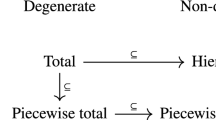Abstract
We define a restricted domain as the discrete set of points representing any convex, four-connected, filled polygon whose (i) vertices lie on the lattice points, (ii) interior angles are multiples of 45°, and (iii) number of sides are at most eight. We describe the boundary code and discrete half-plane representation and use them for representing restricted domains. Morphological operations of dilation and n-fold dilation on the restricted domains with structuring elements that are also restricted domains are expressed in terms of the above representations. We give algorithms for these operations and prove that they are of O(1) complexity and hence are independent of the size of the objects.
We prove that there is a set of 13 restricted domains {K 1, K 2, ..., K 13} such that any given restricted domain K is expressible as % MathType!MTEF!2!1!+-% feaafeart1ev1aaatCvAUfeBSjuyZL2yd9gzLbvyNv2CaerbuLwBLn% hiov2DGi1BTfMBaeXatLxBI9gBaerbd9wDYLwzYbItLDharqqtubsr% 4rNCHbGeaGqiVu0Je9sqqrpepC0xbbL8F4rqqrFfpeea0xe9Lq-Jc9% vqaqpepm0xbba9pwe9Q8fs0-yqaqpepae9pg0FirpepeKkFr0xfr-x% fr-xb9adbaqaaeGaciGaaiaabeqaamaabaabaaGcbaGaam4saiabg2% da9iaadUeadaWgaaWcbaGaaGimaaqabaGccqGHvksXdaqadeqaamaa% xababaGaeyyLIumaleaacaWGRbWaaSbaaWqaaiaaigdaaeqaaaWcbe% aakiaadUeadaWgaaWcbaGaaGymaaqabaaakiaawIcacaGLPaaacqGH% vksXdaqadeqaamaaxababaGaeyyLIumaleaacaWGRbWaaSbaaWqaai% aaikdaaeqaaaWcbeaakiaadUeadaWgaaWcbaGaaGymaaqabaaakiaa% wIcacaGLPaaacqGHvksXcaGGUaGaaiOlaiaac6cacqGHvksXdaqade% qaamaaxababaGaeyyLIumaleaacaWGRbWaaSbaaWqaaiaaigdacaaI% ZaaabeaaaSqabaGccaWGlbWaaSbaaSqaaiaaigdacaaIZaaabeaaaO% GaayjkaiaawMcaaaaa!5B9E!\[K = K_0 \oplus \left( {\mathop \oplus \limits_{k_1 } K_1 } \right) \oplus \left( {\mathop \oplus \limits_{k_2 } K_1 } \right) \oplus ... \oplus \left( {\mathop \oplus \limits_{k_{13} } K_{13} } \right)\] where % MathType!MTEF!2!1!+-% feaafeart1ev1aaatCvAUfeBSjuyZL2yd9gzLbvyNv2CaerbuLwBLn% hiov2DGi1BTfMBaeXatLxBI9gBaerbd9wDYLwzYbItLDharqqtubsr% 4rNCHbGeaGqiVu0Je9sqqrpepC0xbbL8F4rqqrFfpeea0xe9Lq-Jc9% vqaqpepm0xbba9pwe9Q8fs0-yqaqpepae9pg0FirpepeKkFr0xfr-x% fr-xb9adbaqaaeGaciGaaiaabeqaamaabaabaaGcbaWaaeWabeaada% WfqaqaaiabgwPifdWcbaGaam4AamaaBaaameaacaWGPbaabeaaaSqa% baGccaWGlbWaaSbaaSqaaiaadMgaaeqaaaGccaGLOaGaayzkaaaaaa!3DCB!\[\left( {\mathop \oplus \limits_{k_i } K_i } \right)\] represents the k i -fold dilation of K i and K 0 is a translation. We show that this entails a linear transformation from a 13-dimensional space in which restricted domains are represented in terms of n-fold dilations of the 13 basis structuring elements, to an eight-dimensional space in which restricted domains are represented in terms of their eight side lengths. Furthermore, we show that any particular decomposition forms a particular solution of this transformation and that finding all possible dilation decompositions of a restricted domain is equivalent to finding the general solution of this transformation. Finally, we derive a finite-step algorithm for finding a particular decomposition and then give an algorithm for finding all possible decompositions.
Similar content being viewed by others
References
L. Guibas, L. Ramshaw, and J. Stolfi, “A Kinetic Framework for Computational Geometry,” in Proc. IEEE 24th Annual Symposium on Foundations of Computer Science, 1983, pp. 100–111.
L. Guibas, “Computational Geometry,” unpublished notes.
P.K. Ghosh, “A Mathematical Model for Shape Description using Minkowski Operations,” Comput. Vis., Graph., Image Process., vol. 44, 1988, pp. 239–269.
I. Pitas and A.N. Venetsanopoulos, “Morphological Shape Decomposition,” IEEE Trans. Patt. Anal. Mach. Intell., vol. PAMI-12, 1990, pp. 38–45.
J. Xu, “The Optimal Implementation of Morphological Operations on Neighborhood Connected Array Processors,” in Proc. IEEE Conference on Computer Vision and Pattern Recognition, San Diego, CA, 1989, pp. 166–171.
J. Xu, “The Decomposition of Convex Polygonal Morphological Structuring Elements into Neighborhood Subsets,” IEEE Trans. Patt. Anal. Mach. Intell., vol. PAMI13, 1991, pp. 153–162.
D. Sinha and C.R. Giardina, “Discrete Black and White Object Recognition via Morphological Functions,” IEEE Trans. Patt. Anal. Mach. Intell., vol. PAMI-12 1990, pp. 275–293.
T. Lozano-Perez, “Spatial Planning: A Configuration Space Approach,” IEEE Trans. Comput., vol. C-32 1983, pp. 108–120.
B. Grunbaum, Convex Polytopes, New York: Wiley-Interscience, 1967.
H. Freeman, “Computer Processing of Line-Drawing Images,” Comput. Surveys, vol. 6, 1974, pp. 57–97.
T. Kanungo, R.M. Haralick, and Z. Zhuang, “B-Code Dilation and Decomposition of Restricted Convex Shapes,” Proc. Soc. Photo-Opt. Instrum. Engrg., vol. 1350 1990.
T. Kanungo and R.M. Haralick, “Discrete Half-Plane Morphology for Restricted Domains,” in Mathematical Theory in Image Processing E. Dougherty, ed., New York: Marcel Dekker, 1991.
T. Kanungo, “Discrete Half-Plane Morphology and Decomposition of restricted domains,” master's thesis, University of Washington, Seattle, WA, 1990.
T. Kanungo and R.M. Haralick, “Morphological Decomposition of Restricted Domains: A Vector Space Solution,” in Proc. IEEE Conference on Computer Vision and Pattern Recognition, Urbana, IL, 1992.
R.M. Haralick, S.R. Sternberg, and X. Zhuang, “Image Analysis using Mathematical Morphology,” IEEE Trans. Patt. Anal. Mach. Intell. vol. PAMI-9 1987, pp. 532–550.
R.M. Haralick and L.G. Shapiro, Machine Vision, Reading, MA: Addison-Wesley, 1992.
C.R. Giardina and E.R. Dougherty, Morphological Methods in Image and Signal Processing, Englewood Cliffs, NJ: Prentice-Hall, 1988.
J. Serra, Image Analysis and Mathematical Morphology, New York: Academic Press, 1982.
D.H. Ballard and C.M. Brown, Computer Vision, Englewood Cliffs, NJ: Prentice-Hall, 1982.
E. Kreyzig, Advanced Engineering Mathematics, New York: John Wiley, 1962.
Author information
Authors and Affiliations
Rights and permissions
About this article
Cite this article
Kanungo, T., Haralick, R.M. Vector-space solution for a morphological shape-decomposition problem. J Math Imaging Vis 2, 51–82 (1992). https://doi.org/10.1007/BF00123881
Issue Date:
DOI: https://doi.org/10.1007/BF00123881




